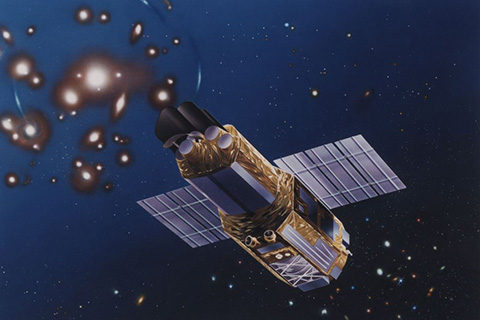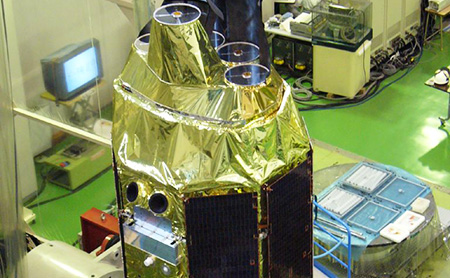About X-ray Astronomy Satellite "Suzaku" (ASTRO-EII)

|
Suzaku to probe into black holes and galaxy clusters to study their structure and evolution.Suzaku (ASTRO-EII), the fifth in a series of Japanese X-ray astronomy satellites, is operation through international cooperation between the United States and Japan. Suzaku is designed to perform various kinds of observational studies of a wide variety of X-ray sources, with higher energy resolution and a higher sensitivity than ever before, over a wider energy range of soft X-rays to gamma-rays (0.4-600 keV). It uses dramatically improved instruments derived from those used for ASCA (ASTRO-D), the previous Japanese X-ray observatory, which was launched in August 1993. Launch date: July 10, 2005 |
|---|
Characteristics of X-ray Astronomy Satellite "Suzaku" (ASTRO-EII)
World-class X-ray observation systems will be developed through international cooperation, for better understanding of the dynamically changing universe through the X-ray images and spectra that the systems will return to Earth.
|
Some dynamically active hot parts of the Universe contain a great amount of outflowing kinetic energy and mass, mostly in the form of X-rays. The best way to understand the processes occurring in these powerfully active areas - such as the vicinities of neutron stars or black holes, supernova remnants, galactic nuclei and galaxy clusters - is by studying X-ray emissions from these areas. These emissions are not observable from Earth because they are absorbed or scattered as they pass through the atmosphere. Hence, we need satellites to do the job in outer space. Suzaku uses five soft X-ray telescopes attached to three different types of instruments. These telescopes boast the world’s most effective energy range. One has an X-ray spectroscope that will measure the energy of individual X-ray photons with a precision 10 times greater than previous instruments. Each of the remaining four has a CCD camera that can return high-quality, clear X-ray pictures and spectra to Earth. ASTRO-E also carries a hard X-ray detector with the capacity to cover high-energy, or "hard," X-rays at the highest sensitivity ever achieved. |

|
|---|
Suzaku is characterized by the super-precision instruments it carries to observe high-energy processes in the Universe, such as those occurring in black holes and galaxy clusters. These instruments, which use Japan’s world-leading technology in this field, can perform precise measurement of the Doppler effect of line X-rays - something that has been difficult to accomplish with existing instruments. Suzaku will enable us to observe in detail the dynamics of the gas in merging gigantic galaxy clusters, as well as the motion and physical state of matter falling into a huge black hole. The increased sensitivity of the instruments will allow the observation of dark primitive stars in faraway galaxies, and make a significant contribution to the understanding of the evolution of the Universe and of the time-space structure.
Suzaku (ASTRO-EII) is launched at 12:30 p.m. on July 10, 2005 (Japan Standard Time, JST) from the Uchinoura Space Center (USC) by M-V.
Major Characteristics
| International Designation Code | 2005-025A |
|---|---|
| Launch Date | 12:30, July 10, 2005 (JST) |
| Launch Vehicle | M-V-6 |
| Location | Uchinoura Space Center |
| Shape | 6.5m, 2.0m, 1.9m Octagonal column with two solar array paddles (folded into thirds) 5.4m full width at deployment of solar paddle |
| Weight | 1700 kg (at launch) |
| Orbiter | Circular |
| Altitude | 570km |
| Inclination | 31 degrees |
| Period | 96 minutes |
Mission talk by team leaders

|
Project Manager Kazuhisa MitsudaHere are messages from Project Managers. |
|---|

